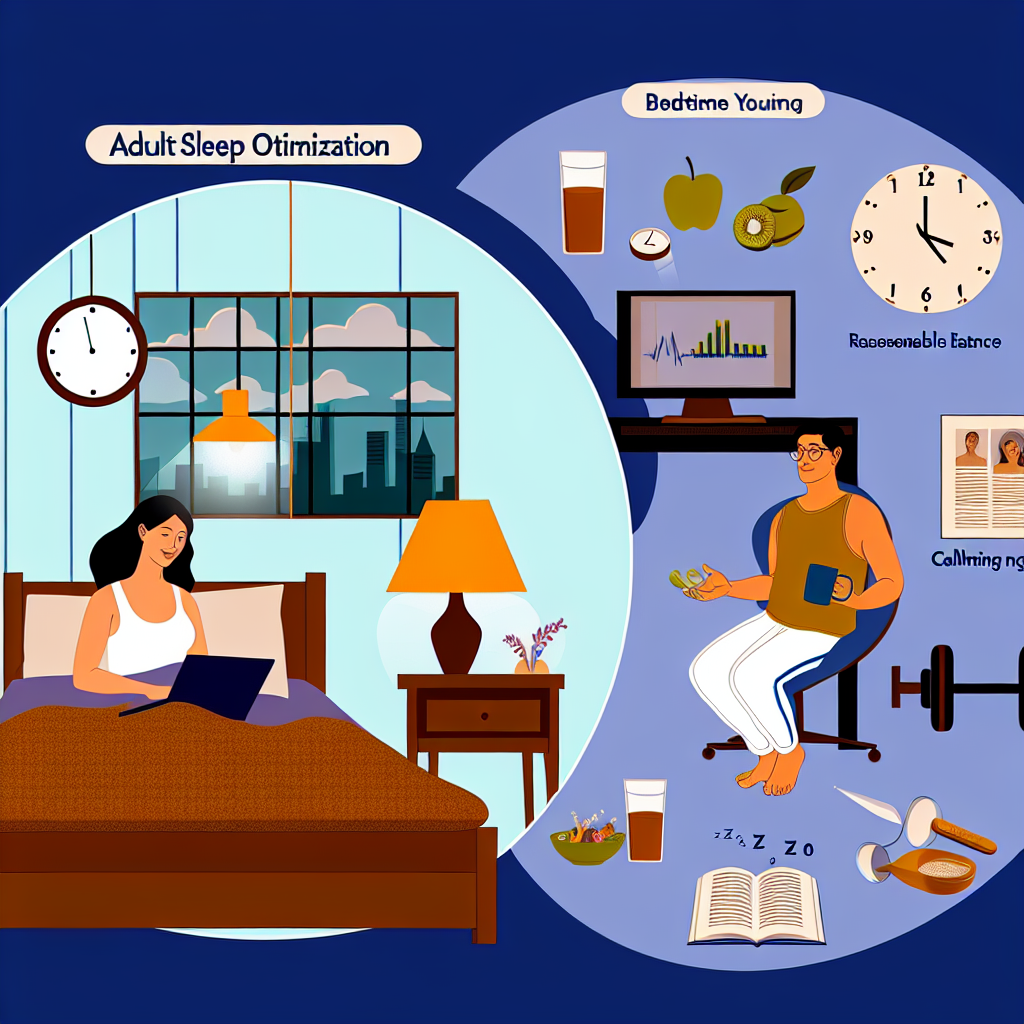Adult Sleep Optimization: 30s to 50s Guide
Introduction
Sleep is an essential component of overall health, yet many adults in their 30s, 40s, and 50s struggle to consistently get quality rest. As we age, lifestyle changes, increasing responsibilities, and physiological shifts can significantly impact sleep quality. Career demands, parenting, stress, and hormonal fluctuations all contribute to sleep disturbances that affect energy levels, cognitive function, metabolism, and immune strength.
Adults in this age range often go through periods of chronic sleep deprivation without realizing the impact it has on their health. Poor sleep has been linked to conditions such as cardiovascular disease, diabetes, obesity, anxiety, and diminished cognitive performance. Studies suggest that getting less than 7 hours of sleep per night can increase the risk of chronic health conditions, accelerate aging, and impair day-to-day functioning.
The good news is that optimizing sleep during your 30s, 40s, and 50s can significantly enhance long-term well-being. Establishing healthy sleep habits through proper sleep hygiene, diet, and lifestyle choices can improve sleep efficiency, duration, and quality. Understanding the natural changes in sleep architecture as you age allows you to take proactive measures to support restful sleep.
This guide will provide a science-backed approach to sleep optimization for adults in their 30s to 50s. We will break down the physiological, lifestyle, and environmental factors affecting sleep, as well as key strategies to improve sleep health. Whether you’re struggling with occasional restlessness, insomnia, or sleep disturbances due to stress or hormonal changes, implementing these evidence-based techniques can help you achieve better restorative sleep and long-term health benefits.
By prioritizing quality sleep now, you not only enhance daily performance and mood but also protect your body from age-related health risks. Let’s explore how you can optimize sleep between your 30s and 50s for a healthier, more energized life.
Scientific Insights into Adult Sleep Optimization
Several scientific studies and medical observations support the importance of sleep optimization during the middle ages of adulthood. Understanding these physiological and psychological changes can set the foundation for lasting sleep health improvements.
How Hormonal and Metabolic Changes Affect Sleep
As we enter our 30s and beyond, hormonal changes play a significant role in sleep patterns. A study published in the Journal of Clinical Endocrinology & Metabolism found that melatonin secretion decreases with age, leading to lighter and less restorative sleep. Additionally, declines in growth hormone levels—essential for tissue repair and cellular function—can contribute to fragmented sleep.
Moreover, research indicates that adults in their 40s and 50s often experience fluctuations in cortisol levels due to stress, which can lead to difficulties falling and staying asleep. Increased stress-related cortisol disrupts the body’s circadian rhythm and reduces deep sleep stages, further exacerbating issues like fatigue and irritability.
How Sleep Architecture Changes with Age
Studies show that as we age, we tend to experience lighter sleep and shorter deep sleep phases (stages 3 and 4 of non-REM sleep). Research in Neuroscience & Biobehavioral Reviews explains that sleep efficiency (the percentage of actual sleep spent in bed) typically decreases due to increased nighttime awakenings. This is why many adults in their 40s and 50s report more frequent nocturnal awakenings and less refreshing sleep.
Additionally, a study in the Journal of Sleep Research observed that sleep latency (the time it takes to fall asleep) tends to increase with age, partially due to a decrease in evening melatonin production.
Lifestyle Habits and Sleep Disorders Impacting Sleep
Other significant factors include lifestyle habits such as late-night screen use, caffeine consumption, and irregular sleep schedules. The blue light emitted by electronic devices has been shown to suppress melatonin secretion, making it harder to fall asleep at night.
Moreover, conditions such as obstructive sleep apnea (OSA) and restless legs syndrome (RLS) are more common in adults between 30 and 50 and can contribute to fragmented sleep. The American Journal of Respiratory and Critical Care Medicine reports that untreated sleep apnea increases the risks of cardiovascular disease and cognitive impairment.
Best Practices for Optimizing Sleep in Your 30s, 40s, and 50s
1. Stick to a Consistent Sleep Schedule
Going to bed and waking up at the same time every day—including weekends—helps regulate your body’s internal clock and improves sleep quality.
2. Reduce Blue Light Exposure Before Bed
Avoid electronic screens (phones, tablets, TVs) 1-2 hours before bedtime or use blue light blocking glasses to minimize melatonin suppression.
3. Optimize Your Sleep Environment
Ensure your bedroom is dark, quiet, and cool (between 60–67°F or 16–19°C) to create a sleep-friendly environment that promotes deep rest.
4. Avoid Stimulants and Disruptive Evening Habits
Limit caffeine and alcohol intake in the evenings, as they can interfere with sleep architecture. Instead, wind down with relaxing activities like meditation, reading, or light stretching.
5. Exercise Regularly for Better Sleep
Engaging in moderate exercise during the day enhances sleep quality, but avoid high-intensity workouts close to bedtime as they may interfere with relaxation.
6. Manage Stress and Lower Cortisol Levels
Practice stress-reducing techniques such as mindfulness, deep breathing, or journaling before bedtime to prevent cortisol-driven sleep disturbances.
By implementing these research-based strategies, you can create an effective sleep routine that supports optimal health and longevity.
Conclusion: Prioritize Sleep for a Healthier Future
Sleep optimization between your 30s and 50s is essential for maintaining long-term physical and mental health. As you navigate career pressures, family obligations, and the natural aging process, prioritizing quality sleep can prevent chronic fatigue, mood disturbances, and health risks associated with poor rest.
Scientific research clearly shows that changes in sleep patterns, hormonal shifts, and lifestyle factors impact sleep quality as we age. By adopting evidence-based sleep strategies—including maintaining a regular sleep schedule, minimizing screen exposure, and fostering a conducive sleep environment—you can significantly enhance your sleep quality.
Ultimately, investing in sleep health now leads to better cognitive function, energy levels, and overall well-being in the decades to come. Make consistent, mindful changes to your sleep routine today, and reap the long-term benefits of improved rest and rejuvenation.
Summary: This comprehensive guide provides science-backed strategies to help adults in their 30s, 40s, and 50s optimize their sleep. By understanding the physiological and lifestyle factors that impact sleep quality, readers can implement evidence-based techniques to establish a healthy sleep routine, improve sleep efficiency, and protect their long-term health and well-being.
References:
1. Journal of Clinical Endocrinology & Metabolism
2. National Library of Medicine – Cortisol and Sleep
3. Neuroscience & Biobehavioral Reviews – Sleep Aging Study
4. Journal of Sleep Research – Melatonin Production and Sleep Latency
5. SAGE Journals – Blue Light and Sleep Suppression
6. American Journal of Respiratory and Critical Care Medicine – Sleep Apnea and Cardiovascular Health

Dominic E. is a passionate filmmaker navigating the exciting intersection of art and science. By day, he delves into the complexities of the human body as a full-time medical writer, meticulously translating intricate medical concepts into accessible and engaging narratives. By night, he explores the boundless realm of cinematic storytelling, crafting narratives that evoke emotion and challenge perspectives.
Film Student and Full-time Medical Writer for ContentVendor.com




